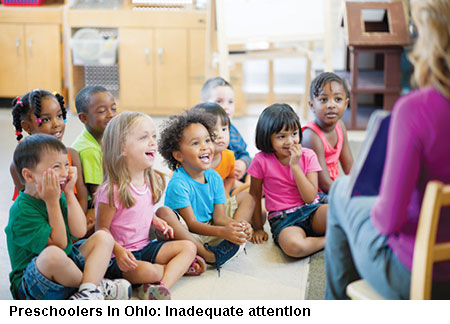 From hot dogs, to automobiles, to diesel fuel, Americans have been touched by plenty of German inventions. Kindergarten (‘children-garden’) is one of them. The programme for educating youngest children through play and social interaction, meant to ease transition from home to formal schooling, was first brought to America in the 1850s and spread quickly. Kindergarten has flourished, becoming so entrenched that it is part of the formal education system’s name (‘K through 12’). Yet the garden of even younger Americans, including preschoolers, has too often gone uncultivated.
From hot dogs, to automobiles, to diesel fuel, Americans have been touched by plenty of German inventions. Kindergarten (‘children-garden’) is one of them. The programme for educating youngest children through play and social interaction, meant to ease transition from home to formal schooling, was first brought to America in the 1850s and spread quickly. Kindergarten has flourished, becoming so entrenched that it is part of the formal education system’s name (‘K through 12’). Yet the garden of even younger Americans, including preschoolers, has too often gone uncultivated.
The share of three and four-year-olds enrolled in preschool hasn’t changed much in two decades. While the average country in the OECD, a club of rich nations, enrolls 80 percent of its three and four-year-old children in school, America enrolls just 54 percent, lagging behind Chile and Mexico. This is true despite abundant evidence of the benefits of early education, especially for disadvantaged children. High-quality preschool programmes can have lasting benefits, including improving the odds of graduating from school, earning more and staying away from drugs and out of prison. For parents there are gains, too: when their children are in day care, they can work.
In the shadows of a government shutdown and chaotic governance generally, one achievement of President Donald Trump’s administration has gone unnoticed. In 2018, Congress approved more than $5.2 billion (Rs.37,440 crore) in “childcare and development block grants”, which subsidise child care for low-income families, nearly doubling available funding and indicating a rare example of bipartisan collaboration. Head Start, a federal programme that educates poor children before they enter kindergarten, has also received more funding.
In the 36 gubernatorial elections held last November, 29 winning candidates either publicly commented on the importance of early childhood education or supported such programmes. For example, Mike DeWine, the Republican governor of Ohio who assumed office in January, promised expanded access to preschools during his campaign. In a politically symbolic move, his first staffing announcement was to choose a director of children’s initiatives. California’s new governor Gavin Newsom, a Democrat, has the biggest and most closely watched plans of any state. He recently announced $1.2 billion (Rs.8,539 crore) in new funding directed at the spectrum of young children’s needs, from home visits, to affordable childcare, to expanded pre-K.
Such widespread support tends to mask two trade-offs inherent in making early-years education more widely available. First, researchers believe it is better to back smaller, higher-quality programmes. “It’s always easier for a state to go from better to bigger than bigger to better,” says David Kirp, author of The Sandbox Investment (2007), a book about preschool and politics. For impatient politicians, it is tempting to go for scale first.
Second, early-years teachers are often ill-paid. This can hurt the quality of the programmes on offer. Earnings are so paltry that 58 percent of child-care workers in California qualify for some form of public assistance, such as food stamps, says Deborah Stipek of Stanford University. This contributes to extremely high turnover. Around a quarter of child-care workers and preschool teachers leave each year, reckons Scott Moore of Kidango, the Bay Area’s largest preschool provider, who says what early educators earn is “unconscionable”. But making programmes available to everyone makes them more expensive, leaving little to pay teachers more.
(Excerpted and adapted from The Economist and Times Higher Education)























